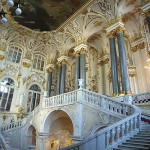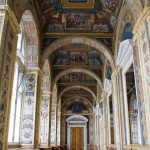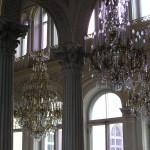The State Hermitage Museum in St Petesburg
- The Hermitage
- Leonardo da Vinchi
- Rembrandt
The State Hermitage Museum, one of the richest museums in the world, has a wonderful collection of art which is divided into six departments representing: Western-European art; Antique art; Art from the oriental part of Russia; Oriental art from Byzantium and Persia; the Archaeological department of Primitive art; and Russian Art.
The collection was started in 1764 by Russian Empress Catherine the Second when she purchased 225 canvases by the most distinguished painters in the history of art in Berlin. By the end of Catherine the Second’s reign the collection of the State Hermitage Museum had grown to 2000 items. As a result of her various interests, the Hermitage owns the best collection of French eighteenth century bronzes and paintings outside of France, as well as vast collections of engraved gems, books, furniture, coins, medals, and a copy of Raphael’s Loggia from the Vatican.
The Small Hermitage near the Winter Palace was erected by French architect Vallin de la Mothe for the exhibition of Catherine’s treasures. Later, the German architect George Felten built another mansion, named the Large Hermitage adjacent to the Small Hermitage.
The French word «hermitage» means «place of solitude». Catherine the Great wanted to have a place of solitude and privacy in her winter residence, so she used the special pavilion, the Small Hermitage, where she was able to discuss political and personal matters without being overheard.
The windows of the Pavilion Hall face the Neva River. In summer the glass doors on the other side open onto the hanging garden to where private guests of Catherine the Second could come. Contemporaries of the Empress compared the Winter Garden to the Semiramis Gardens, the Hanging Gardens of Babylon. English craftsman James Cox produced the remarkable Peacock Clock. Once a week, on Wednesdays, in the Pavilion Hall of the Small Hermitage the clock is wound. The clock’s peacock spreads its tail, turns from side to side while a cock crows and an owl’s head rotates.
The Winter Palace was built as a royal residence for the kings and queens of Russia. It was constructed in 1754-1762 by the great master of Baroque style, Italian architect Bartolomeo Rastrelli. These architectural masterpieces in Saint Petersburg were commissioned by Elizabeth, daughter of Peter the Great. This building starts the harmonious line of the palaces along the Neva River, four of which belong to the Hermitage museum.
Copies of the world-renowned Loggia in the Vatican, commissioned by Catherine the Great, are in the Gallery of the Hermitage. The Gallery was designed especially for displaying these canvas replicas of the engravings of Raphael’s frescoes. It is abutted to the New Hermitage Museum building, designed by Leo Klenze and constructed in 1842-1851 by architects Vasily Stasov and Nikolai Efimov.
All in all the palace compound of the Hermitage consists of five buildings. One more building for the theatre was also commissioned by Catherine the Great for court performances. The magnificent auditorium of the Hermitage Theatre is designed so that the audience sits in a semi-circle.
All of the five buildings of the Hermitage are joined by suspended corridors. These five are the Winter Palace; the Small Hermitage; then the Large, or Old, Hermitage; the New Hermitage; and the Hermitage Theatre.
The former official suite of rooms leading to the Royal Throne Hall in the Winter Palace starts with the Ambassadors’ Staircase.
The Old Hermitage boasts an exhibition of Italian art which gives a thorough coverage of all trends in the development of Italian art from the 13th century.
Paintings of such artists like Leonardo da Vinci, Giorgione and Titian exhibited in the Old Hermitage building make the collection of the Hermitage museum very valuable.
Raphael, Michelangelo da Caravaggio and Canaletto’s paintings are in the New Hermitage building as well as the Dutch collection of the 17th century. The triumph of the Hermitage is the comprehensive collection of the prodigious master, Rembrandt-van Rijn. There are 150 pictures by Spanish masters among which are: Jusepe de Ribera, Diego Velazquez and Bartolome Esteban Murillo. The scale of the artworks demanded huge walls and special lighting in the top-lit halls of the New Hermitage museum building.
The State Hermitage Museum houses one of the finest, largest and best exhibitions of French Impressionists in the world.
The magnificent interiors of the 19th century former private premises of the Winter Palace are also part of the collection of the Hermitage Museum.




